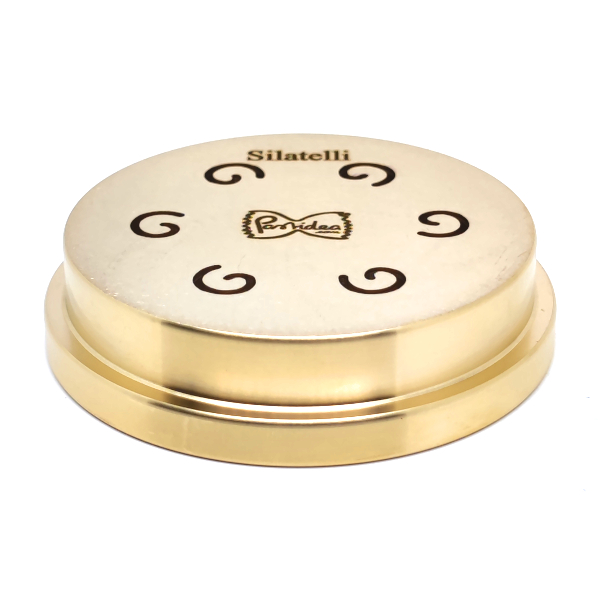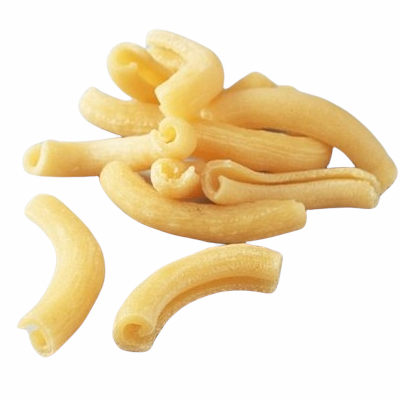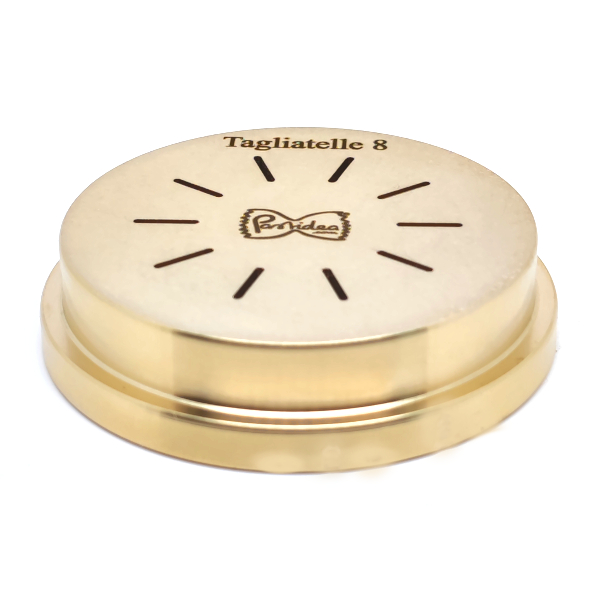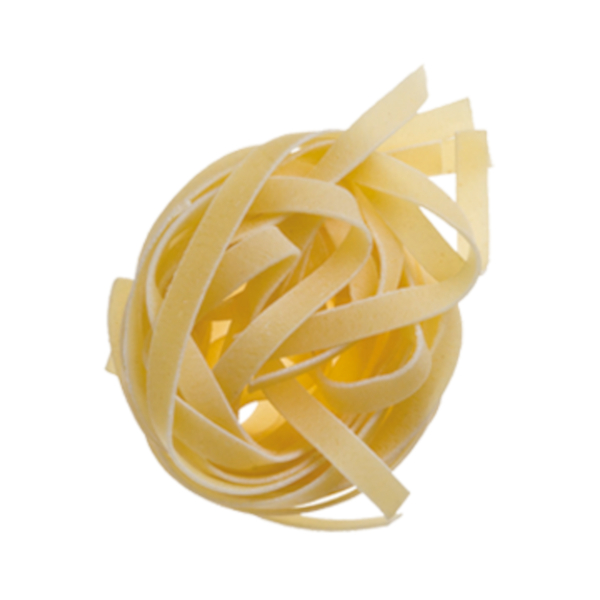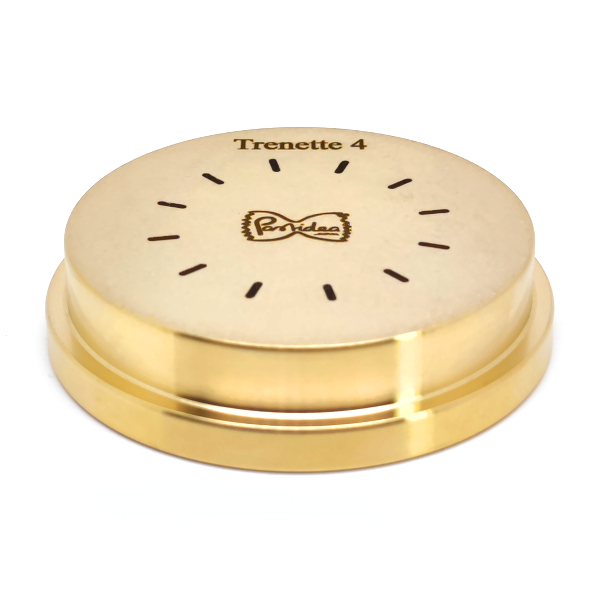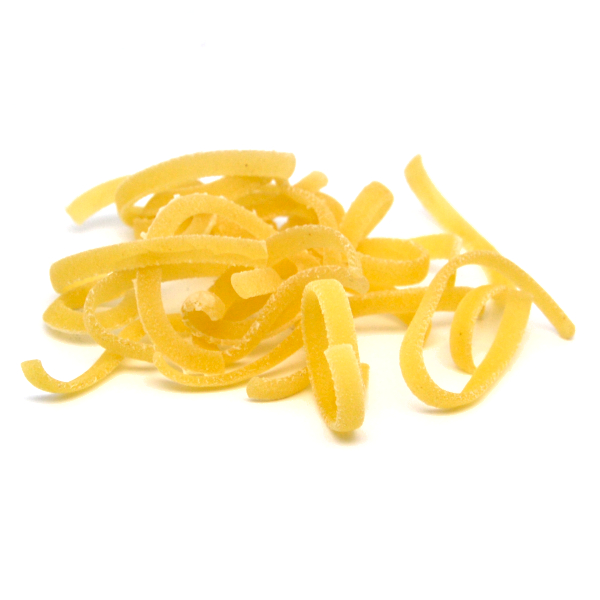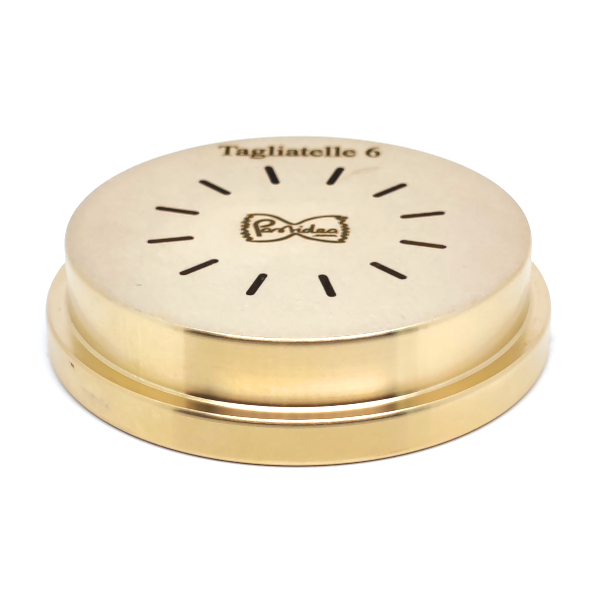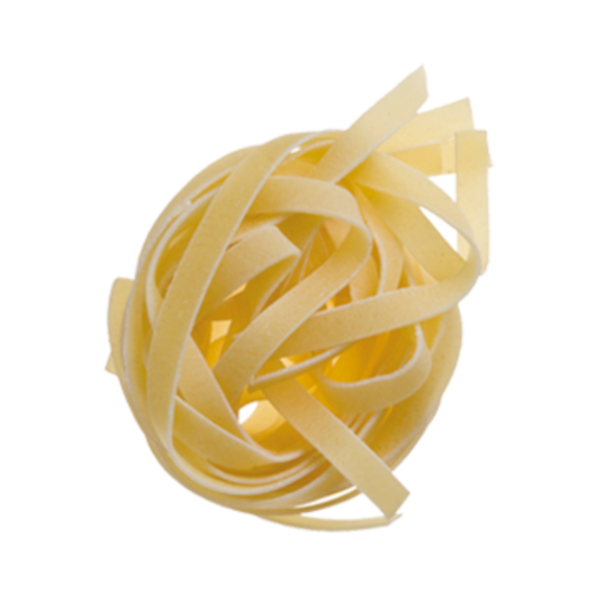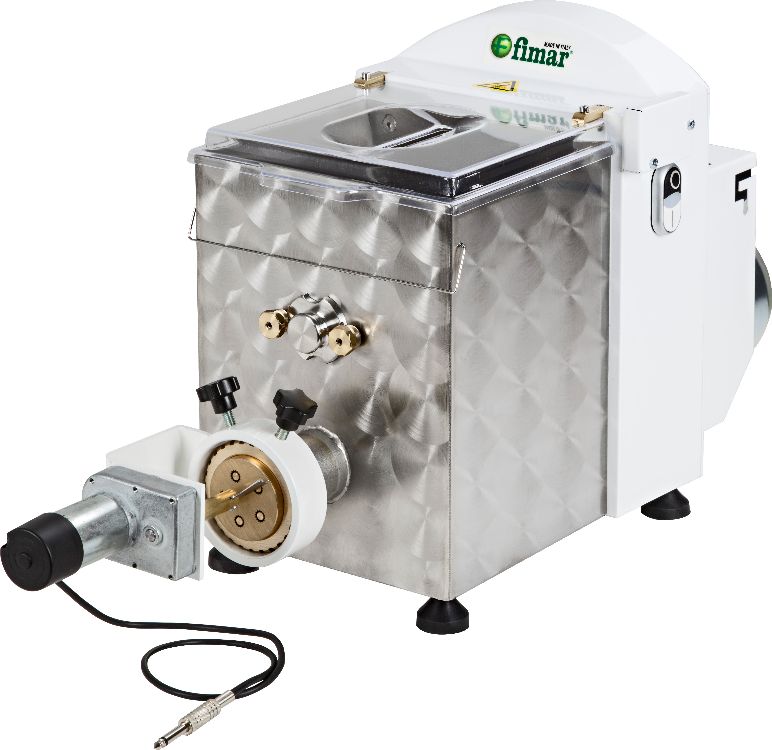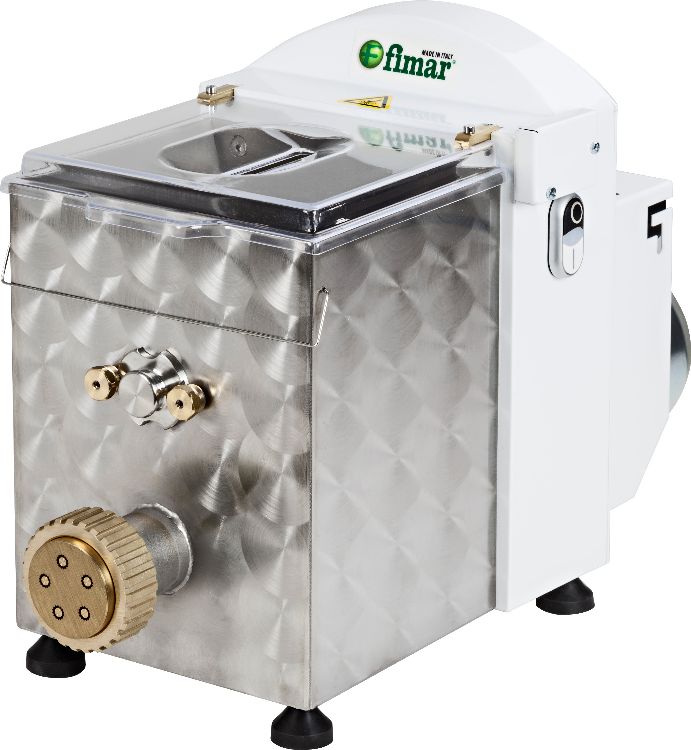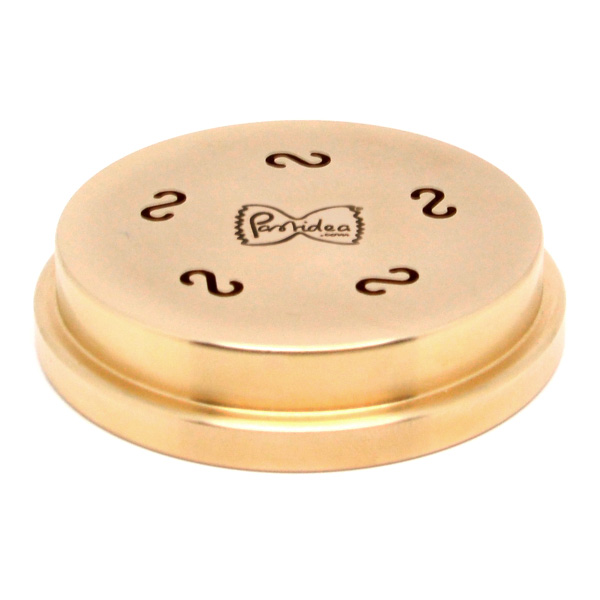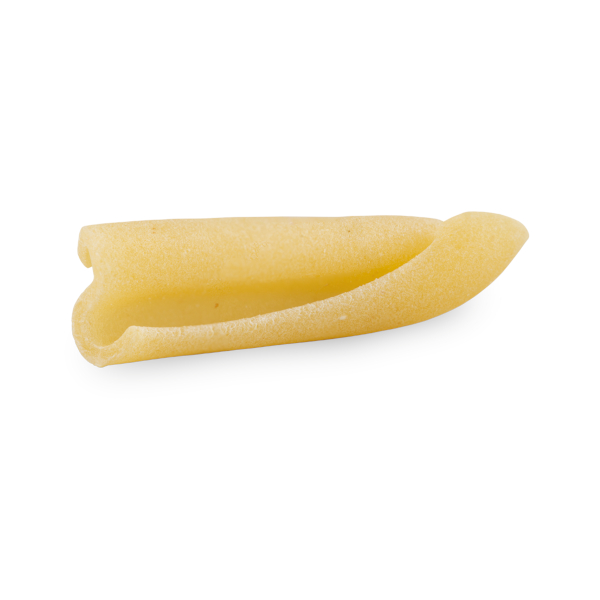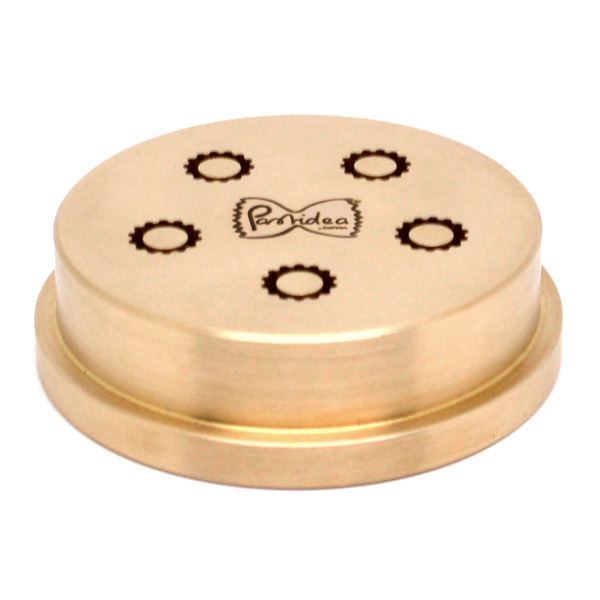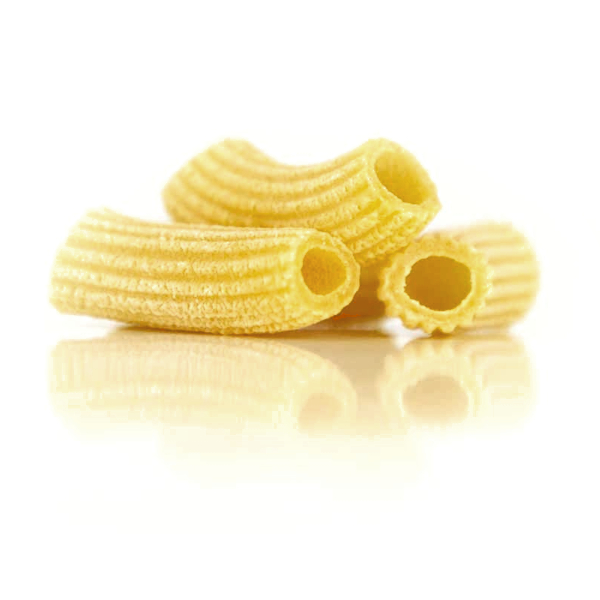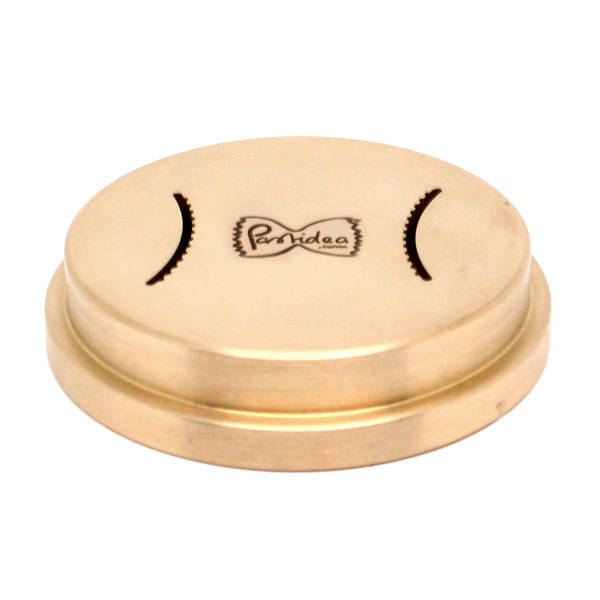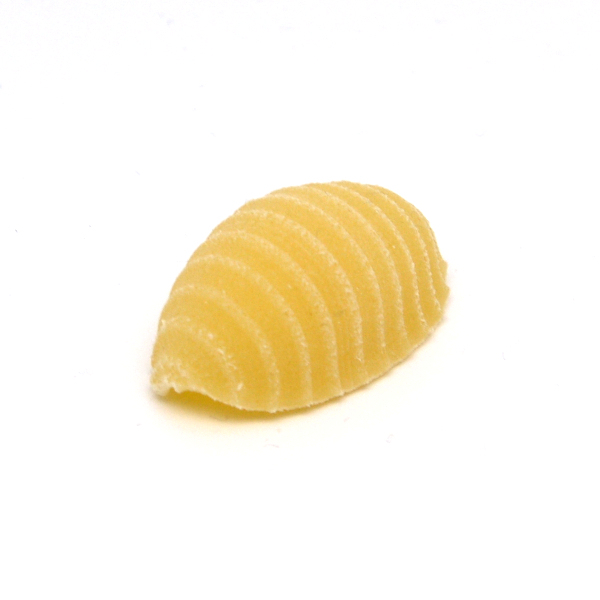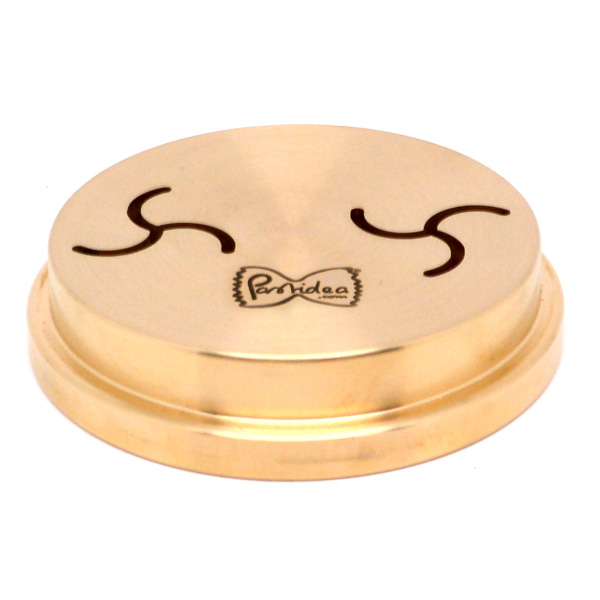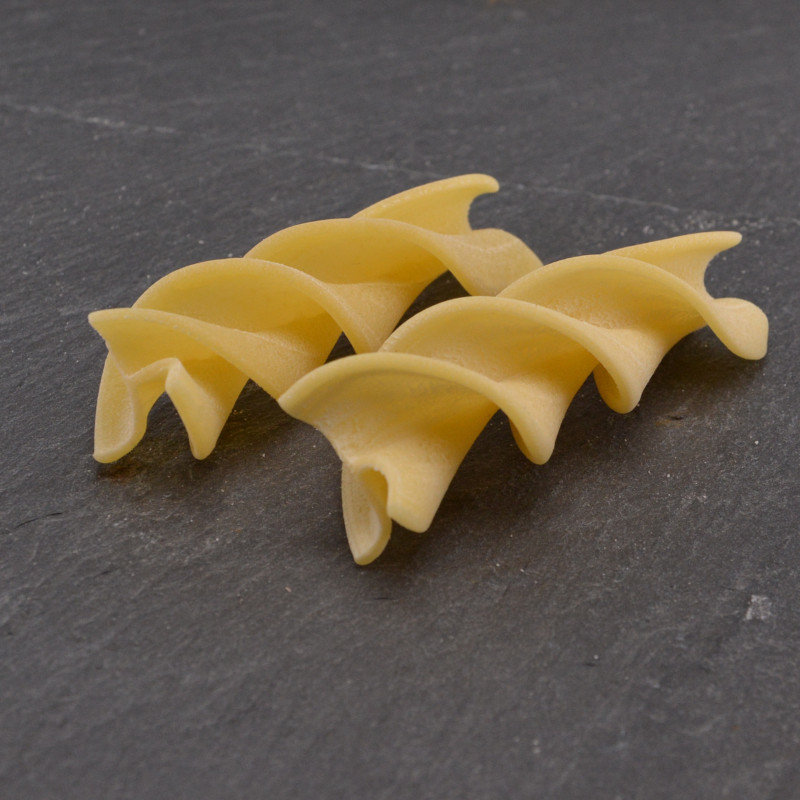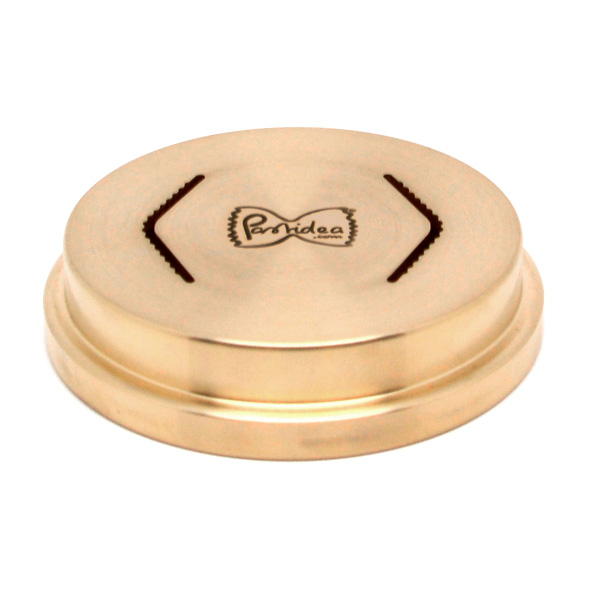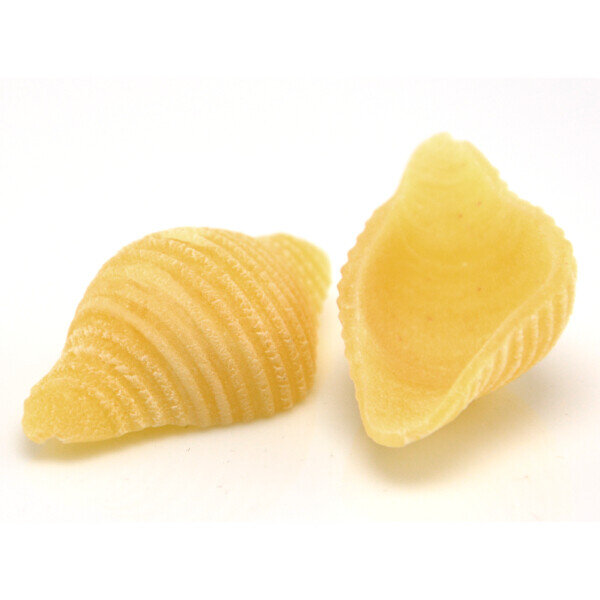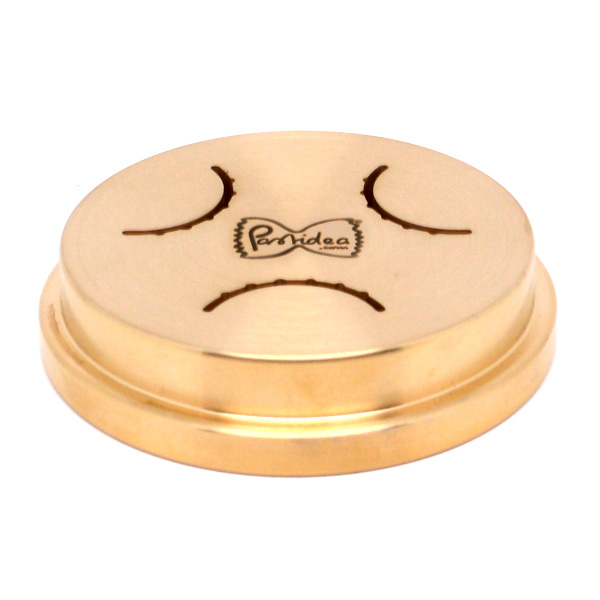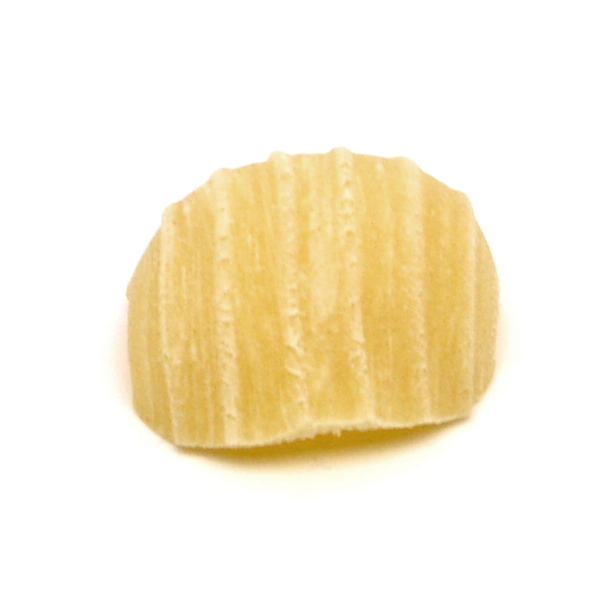Original price was: €83,9052,40 €Current price is: €52,40. incl. VAT plus shipping costs
VAT included
excl. Shipping Rate
Bronze die - Silatelli Size: 8 mm Thickness: 1,1 mm Diameter of die: 63,5 mm pasta insert for the following professional pasta machines: La Fattorina VIP2 La Fattorina VIP4 Fimar MPF 2.5 Fimar MPF 4 Fimar PF25E Fimar PF40E Fimar NMF8 No adapter or similar is required. The die fits directly into the above-mentioned pasta machines. Why bronze: Bronze dies were the traditional way of making pasta. The pasta made “al bronzo” can only be found rarely and usually only in selected delicatessens. By pressing the pasta dough through the bronze matrices, the surface of the pasta is slightly roughened at the same time, making the pasta easier to grip. This allows the pasta to better absorb the sauce, flavors and spices later on. Would you like to learn more about bronze matrices? Then we recommend this article to you here. Recipe: It is recommended to use durum wheat semolina, enough cold liquid such as water and/or egg. The dough should be kneaded for about 8-10 minutes, this is the only way the gluten from the durum wheat can fully develop. The result should be a moist, crumbly dough. You can find a standard recipe for our matrices here. The matrices can also be used to produce gluten-free pasta. Storage: Do you have several bronze matrices and are looking for storage to protect the matrix from dust and darkening caused by light? Then we recommend our storage systems to you here .
Original price was: €83,9052,40 €Current price is: €52,40. incl. VAT plus shipping costs
VAT included
excl. Shipping Rate
Bronze die - Tagliatelle 8 mm They are considered a classic pasta from the Emilia-Romagna region of Italy. The individual noodle is shaped like a long flat ribbon, similar to fettuccine, but slightly wider, typically around 5-10 mm. Size: 8 mm Thickness: 1 mm Diameter of die: 63,5 mm pasta insert for the following professional pasta machines: La Fattorina VIP2 La Fattorina VIP4 Fimar MPF 2.5 Fimar MPF 4 Fimar PF25E Fimar PF40E Fimar NMF8 No adapter or similar is required. The die fits directly into the above-mentioned pasta machines. Why bronze: Bronze dies were the traditional way of making pasta. The pasta made “al bronzo” can only be found rarely and usually only in selected delicatessens. By pressing the pasta dough through the bronze matrices, the surface of the pasta is slightly roughened at the same time, making the pasta easier to grip. This allows the pasta to better absorb the sauce, flavors and spices later on. Would you like to learn more about bronze matrices? Then we recommend this article to you here. Recipe: It is recommended to use durum wheat semolina, enough cold liquid such as water and/or egg. The dough should be kneaded for about 8-10 minutes, this is the only way the gluten from the durum wheat can fully develop. The result should be a moist, crumbly dough. You can find a standard recipe for our matrices here. The matrices can also be used to produce gluten-free pasta. Storage: Do you have several bronze matrices and are looking for storage to protect the matrix from dust and darkening caused by light? Then we recommend our storage systems to you here .
Original price was: €83,9052,40 €Current price is: €52,40. incl. VAT plus shipping costs
VAT included
excl. Shipping Rate
Bronze die - Trenette 4 mm It is a classic pasta from the Liguria region around Genoa in Italy, which is very similar to fettuccine and tagliatelle. Size: 4 mm Thickness: 1 mm Diameter of die: 63,5 mm pasta insert for the following professional pasta machines: La Fattorina VIP2 La Fattorina VIP4 Fimar MPF 2.5 Fimar MPF 4 Fimar PF25E Fimar PF40E Fimar NMF8 No adapter or similar is required. The die fits directly into the above-mentioned pasta machines. Why bronze: Bronze dies were the traditional way of making pasta. The pasta made “al bronzo” can only be found rarely and usually only in selected delicatessens. By pressing the pasta dough through the bronze matrices, the surface of the pasta is slightly roughened at the same time, making the pasta easier to grip. This allows the pasta to better absorb the sauce, flavors and spices later on. Would you like to learn more about bronze matrices? Then we recommend this article to you here. Recipe: It is recommended to use durum wheat semolina, enough cold liquid such as water and/or egg. The dough should be kneaded for about 8-10 minutes, this is the only way the gluten from the durum wheat can fully develop. The result should be a moist, crumbly dough. You can find a standard recipe for our matrices here. The matrices can also be used to produce gluten-free pasta. Storage: Do you have several bronze matrices and are looking for storage to protect the matrix from dust and darkening caused by light? Then we recommend our storage systems to you here .
Original price was: €83,9052,40 €Current price is: €52,40. incl. VAT plus shipping costs
VAT included
excl. Shipping Rate
Bronze die - Tagliatelle 6mm They are considered a classic pasta from the Emilia-Romagna region of Italy. The individual noodle is shaped like a long flat ribbon, similar to fettuccine, but slightly wider, typically around 5-10 mm Size: 6 mm Thickness: 1 mm Diameter of die: 63,5 mm pasta insert for the following professional pasta machines: La Fattorina VIP2 La Fattorina VIP4 Fimar MPF 2.5 Fimar MPF 4 Fimar PF25E Fimar PF40E Fimar NMF8 No adapter or similar is required. The die fits directly into the above-mentioned pasta machines. Why bronze: Bronze dies were the traditional way of making pasta. The pasta made “al bronzo” can only be found rarely and usually only in selected delicatessens. By pressing the pasta dough through the bronze matrices, the surface of the pasta is slightly roughened at the same time, making the pasta easier to grip. This allows the pasta to better absorb the sauce, flavors and spices later on. Would you like to learn more about bronze matrices? Then we recommend this article to you here. Recipe: It is recommended to use durum wheat semolina, enough cold liquid such as water and/or egg. The dough should be kneaded for about 8-10 minutes, this is the only way the gluten from the durum wheat can fully develop. The result should be a moist, crumbly dough. You can find a standard recipe for our matrices here. The matrices can also be used to produce gluten-free pasta. Storage: Do you have several bronze matrices and are looking for storage to protect the matrix from dust and darkening caused by light? Then we recommend our storage systems to you here .
1.998,00 € incl. VAT plus shipping costs
VAT included
excl. Shipping Rate
Fimar MPF 2,5 NC pasta machine including cutting device Pasta machine, perfect for large families, pastaholics as well as farm shops and restaurants. Simply put dry ingredients into the kneading tray, add the liquid ingredients and knead for approx. 8-10 minutes and dispense with a die of your choice. Boiler and dough hook are made of solid AISI 304 stainless steel. Safety switch on the lid. Lid with filling opening. Lid made of stainless steel The technical data at a glance: Power 230 V/0,37 KW Device dimensions 260 x 600 x 380 mm Boiler volume 2,5 kg (dry ingredients plus liquid) Dough per hour up to 8,0 kg Machine weight 30,0 kg Can be expanded with matrices in many different formats. The delivery takes place without a matrix or adapter. Made in Italy. Delivery takes place via a shipping company. The shipping costs within Germany are included in the price. 2 years repair service If a defect occurs during the first two years after purchase, the machine will be repaired by a cooperation partner based in Germany (i.e. the machine does not have to be sent back to Italy). Re-used probes Price only applies to shipping to Germany (free shipping). Other countries after prior consultation You don't just buy a pasta machine of this size. You are welcome to contact us at any time to clarify any open questions. Gladly via message or telephone. We are looking forward to your contact.
1.490,00 € incl. VAT plus shipping costs
VAT included
excl. Shipping Rate
Pasta machine Fimar MPF 2,5 N Pasta machine, perfect for large families, pastaholics as well as farm shops and restaurants. Simply put dry ingredients into the kneading tray, add the liquid ingredients and knead for approx. 8-10 minutes and dispense with a die of your choice. Boiler and dough hook are made of solid AISI 304 stainless steel. Safety switch on the lid. Lid with filling opening. Lid made of stainless steel The technical data at a glance: Power 230 V/0,37 KW Device dimensions 260 x 600 x 380 mm Boiler volume 2,5 kg (dry ingredients plus liquid) Dough per hour up to 8,0 kg Machine weight 29,0 kg Delivery without die or adapter. Can be expanded with matrices in many different formats. Made in Italy. Delivery takes place via a shipping company. The shipping costs within Germany are included in the price. 2 years repair service If a defect occurs during the first two years after purchase, the machine will be repaired by a cooperation partner based in Germany (i.e. the machine does not have to be sent back to Italy). Promotional price Price only applies to shipping to Germany (free shipping). Other countries after prior consultation You don't just buy a pasta machine of this size. You are welcome to contact us at any time to clarify any open questions. Gladly via message or telephone. We are looking forward to your contact.
Original price was: €83,9052,40 €Current price is: €52,40. incl. VAT plus shipping costs
VAT included
excl. Shipping Rate
Casarecce bronze die 8 mm Casarecce, translated as “homemade”, originally comes from Sicily, but can also often be found in central and southern Italy. Harmonize wonderfully with Ragu or any other sauce. Size: 10 mm Thickness: 1,1 mm Diameter die: 63,5 mm Pasta insert for the following professional pasta machines: La Fattorina VIP2 La Fattorina VIP4 Fimar MPF 2.5 Fimar MPF 4 Fimar PF25E Fimar PF40E Fimar NMF8 No adapter or similar is required . The die fits directly into the above-mentioned pasta machines. Why bronze: Bronze dies were the traditional way of making pasta. The pasta made “al bronzo” can only be found rarely and usually only in selected delicatessens. By pressing the pasta dough through the bronze matrices, the surface of the pasta is slightly roughened at the same time, making the pasta easier to grip. This allows the pasta to better absorb the sauce, flavors and spices later on. Would you like to learn more about bronze matrices? Then we recommend this article to you here. Recipe: It is recommended to use durum wheat semolina, enough cold liquid such as water and/or egg. The dough should be kneaded for about 8-10 minutes, this is the only way the gluten from the durum wheat can fully develop. The result should be a moist, crumbly dough. You can find a standard recipe for our matrices here. The matrices can also be used to produce gluten-free pasta. Storage: Do you have several bronze matrices and are looking for storage to protect the matrix from dust and darkening caused by light? Then we recommend our storage systems to you here .
Original price was: €83,9052,40 €Current price is: €52,40. incl. VAT plus shipping costs
VAT included
excl. Shipping Rate
Bronze matrix Maccheroni Rigati Size: 8,5 mm Thickness: 1,1 mm Diameter die: 63,5 mm Maccheroni (in Switzerland they are better known as magronen) are tube pasta that are slightly larger than bucatini and usually a touch smaller than ziti. Depending on the region, they are sometimes eaten whole long or cut short. You have to be careful not to mix them up. Because the pasta that is mostly sold as maccheroni in Germany is a little smaller than this one. This means that anyone looking for German maccheroni will find what they are looking for in a die called “Bucatini”. Pasta insert for the following professional pasta machines: La Fattorina VIP2 La Fattorina VIP4 Fimar MPF 2.5 Fimar MPF 4 Fimar PF25E Fimar PF40E Fimar NMF8 No adapter or similar is required. The die fits directly into the above-mentioned pasta machines. Why bronze: Bronze dies were the traditional way of making pasta. The pasta made “al bronzo” can only be found rarely and usually only in selected delicatessens. By pressing the pasta dough through the bronze matrices, the surface of the pasta is slightly roughened at the same time, making the pasta easier to grip. This allows the pasta to better absorb the sauce, flavors and spices later on. Would you like to learn more about bronze matrices? Then we recommend this article to you here. Recipe: It is recommended to use durum wheat semolina, enough cold liquid such as water and/or egg. The dough should be kneaded for about 8-10 minutes, this is the only way the gluten from the durum wheat can fully develop. The result should be a moist, crumbly dough. You can find a standard recipe for our matrices here. The matrices can also be used to produce gluten-free pasta. Storage: Do you have several bronze matrices and are looking for storage to protect the matrix from dust and darkening caused by light? Then we recommend our storage systems to you here .
Original price was: €83,9052,40 €Current price is: €52,40. incl. VAT plus shipping costs
VAT included
excl. Shipping Rate
Bronze die Gnocco Sardo The Gnocco Sardo are small, fluted mussels. The name already gives it away. It is a type of gnocchi that people like to eat in Sardinia. Attention: In Sardinia, these gnocchi are always prepared without eggs (i.e. only durum wheat and water). In other areas of Italy people are more tolerant. These noodles are also known under the name Malloreddus. Because the pasta is pulled through a bronze die, the result is a very slightly roughened surface. This means the sauce can be absorbed particularly well. Cavatelli are very similar to Gnocco Sardo. The difference lies in the fine stripes on the surface, while the cavatelli are smooth. Size: 19 mm Thickness: 1,2 mm Diameter die: 63 mm Pasta insert for the following professional pasta machines: La Fattorina VIP2 La Fattorina VIP4 Fimar MPF 2.5 Fimar MPF 4 Fimar PF25E Fimar PF40E Fimar NMF8 No adapter or similar is required. The die fits directly into the above-mentioned pasta machines. Why bronze: Bronze dies were the traditional way of making pasta. The pasta made “al bronzo” can only be found rarely and usually only in selected delicatessens. By pressing the pasta dough through the bronze matrices, the surface of the pasta is slightly roughened at the same time, making the pasta easier to grip. This allows the pasta to better absorb the sauce, flavors and spices later on. Would you like to learn more about bronze matrices? Then we recommend this article to you here. Recipe: It is recommended to use durum wheat semolina, enough cold liquid such as water and/or egg. The dough should be kneaded for about 8-10 minutes, this is the only way the gluten from the durum wheat can fully develop. The result should be a moist, crumbly dough. You can find a standard recipe for our matrices here. The matrices can also be used to produce gluten-free pasta. Storage: Do you have several bronze matrices and are looking for storage to protect the matrix from dust and darkening caused by light? Then we recommend our storage systems to you here .
Original price was: €83,9052,40 €Current price is: €52,40. incl. VAT plus shipping costs
VAT included
excl. Shipping Rate
Bronze die Fusilli A3 22 mm One of the most famous noodles in Germany is fusilli. They are often called Spirelli, Rotini and rarely Eliche. The word fusilli comes from the Italian word “fuso”, which means spindle. In manual fusilli production, spaghetti is still wrapped around a spindle. According to legend, fusilli were invented at the court in Florence around 1550. The cook's son sat under the kitchen table and played with fallen pasta scraps that he wrapped around a knitting needle. These were the first fusillis. Not quite as clear, but much more likely, is the story that the Fusillis originated in southern Italy. At some point, spaghetti began to be rolled up in a spiral for drying, as this rotation made it much easier to dry and store. What is undisputed is that the twists mean that the sauce combines particularly well with the pasta. Fusillis are easy to dry. Fusillis are available with 2, 3 or 5 wings. You can see how many propeller blades the Fusilli has by the die shape and also the die name. Ie a Fusilli A2 has two wings, an A3 has 3 wings, an A5 has 5 wings. Size: 22 mm Thickness: 1,4 mm Diameter die: 63,5 mm Pasta insert for the following professional pasta machines: La Fattorina VIP2 La Fattorina VIP4 Fimar MPF 2.5 Fimar MPF 4 Fimar PF25E Fimar PF40E Fimar NMF8 No adapter or similar is required . The die fits directly into the above-mentioned pasta machines. Why bronze: Bronze dies were the traditional way of making pasta. The pasta made “al bronzo” can only be found rarely and usually only in selected delicatessens. By pressing the pasta dough through the bronze matrices, the surface of the pasta is slightly roughened at the same time, making the pasta easier to grip. This allows the pasta to better absorb the sauce, flavors and spices later on. Would you like to learn more about bronze matrices? Then we recommend this article to you here. Recipe: It is recommended to use durum wheat semolina, enough cold liquid such as water and/or egg. The dough should be kneaded for about 8-10 minutes, this is the only way the gluten from the durum wheat can fully develop. The result should be a moist, crumbly dough. You can find a standard recipe for our matrices here. The matrices can also be used to produce gluten-free pasta. Storage: Do you have several bronze matrices and are looking for storage to protect the matrix from dust and darkening caused by light? Then we recommend our storage systems to you here .
Original price was: €83,9052,40 €Current price is: €52,40. incl. VAT plus shipping costs
VAT included
excl. Shipping Rate
Bronze die Conchiglia Rigata 28 mm “Conchiglia” is the Italian word for “shell”. The conchiglia is related to the conchigliette, the “small mussel”, which is also available as a matrix. In the “gigante” version, i.e. gigantic in size, the maximum has been achieved from the bronze matrix, so that it is also suitable for filling. The “rigata” means that this shell has grooves. Thanks to the grooves and the very finely roughened effect, which can only be achieved with bronze matrices, this mussel can absorb the sauce particularly well. Size: 28 mm Thickness: 1,2 mm Diameter die: 63,5 mm Pasta insert for the following professional pasta machines: La Fattorina VIP2 La Fattorina VIP4 Fimar MPF 2.5 Fimar MPF 4 Fimar PF25E Fimar PF40E Fimar NMF8 No adapter or similar is required . The die fits directly into the above-mentioned pasta machines. Why bronze: Bronze dies were the traditional way of making pasta. The pasta made “al bronzo” can only be found rarely and usually only in selected delicatessens. By pressing the pasta dough through the bronze matrices, the surface of the pasta is slightly roughened at the same time, making the pasta easier to grip. This allows the pasta to better absorb the sauce, flavors and spices later on. Would you like to learn more about bronze matrices? Then we recommend this article to you here. Recipe: It is recommended to use durum wheat semolina, enough cold liquid such as water and/or egg. The dough should be kneaded for about 8-10 minutes, this is the only way the gluten from the durum wheat can fully develop. The result should be a moist, crumbly dough. You can find a standard recipe for our matrices here. The matrices can also be used to produce gluten-free pasta. Storage: Do you have several bronze matrices and are looking for storage to protect the matrix from dust and darkening caused by light? Then we recommend our storage systems to you here .
Original price was: €83,9052,40 €Current price is: €52,40. incl. VAT plus shipping costs
VAT included
excl. Shipping Rate
Bronze die Orecchiette Rigate Orecchiette means something like “little ears” in German. They originally come from the Apulia region with the capital Bari. Traditionally they are made by hand, using a large wooden board, a knife and your fingers. You form a thin roll out of a piece of dough and cut off individual portions, then pull and push them forward at the same time with the handle of a kitchen knife and turn them into small mini ears. In our version, the orecchiette are formed by machine, the shape is slightly different than the hand version, but it is much faster and more relaxed. The sauce can collect easily in the shell shape of the noodle. Size: 21 mm Thickness: 1,1 mm Diameter die: 63,5 mm Pasta insert for the following professional pasta machines: La Fattorina VIP2 La Fattorina VIP4 Fimar MPF 2.5 Fimar MPF 4 Fimar PF25E Fimar PF40E Fimar NMF8 No adapter or similar is required . The die fits directly into the above-mentioned pasta machines. Why bronze: Bronze dies were the traditional way of making pasta. The pasta made “al bronzo” can only be found rarely and usually only in selected delicatessens. By pressing the pasta dough through the bronze matrices, the surface of the pasta is slightly roughened at the same time, making the pasta easier to grip. This allows the pasta to better absorb the sauce, flavors and spices later on. Would you like to learn more about bronze matrices? Then we recommend this article to you here. Recipe: It is recommended to use durum wheat semolina, enough cold liquid such as water and/or egg. The dough should be kneaded for about 8-10 minutes, this is the only way the gluten from the durum wheat can fully develop. The result should be a moist, crumbly dough. You can find a standard recipe for our matrices here. The matrices can also be used to produce gluten-free pasta. Storage: Do you have several bronze matrices and are looking for storage to protect the matrix from dust and darkening caused by light? Then we recommend our storage systems to you here .


